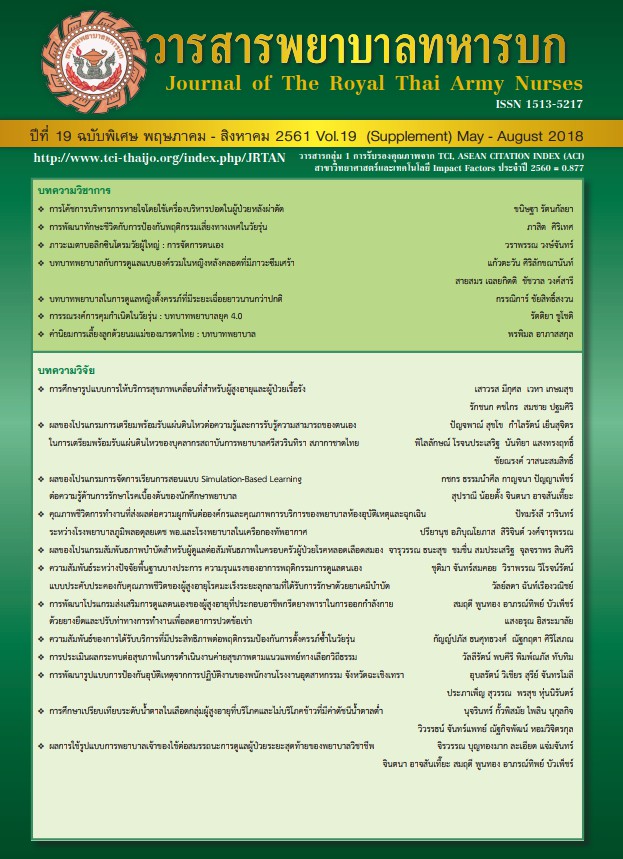Effect of Earthquake Preparation Program on Knowledge and Perceived Self-Efficacy in Earthquake Preparation Among Staffs of Srisavarindhira Thai Red Cross Institute of Nursing
Keywords:
Earthquake preparation program, Knowledge in earthquake, Perceived self-efficacy in earthquake preparation, StaffAbstract
This quasi-experimental research using two groups (pre-posttest designed) aimed to study effect of earthquake preparation program on knowledge and perceived self-efficacy in earthquake preparation among staffs of Srisavarindhira Thai Red Cross Institute of Nursing. The samples of this study were staff who were working at Srisavarindhira Thai Red Cross Institute of Nursing. The total of 66 samples were recruited in sample random sampling technique. Random assignment was used with matched-pair into two groups of experimental group and control group. Thirty-three staffs in the experimental group received the earthquake preparedness program which developed by the researchers and based on the self-efficacy theory of Bandura (1997). Focus on creating successful experiences to achieve self-efficacy for one day. While the other thirty-three staffs control group received only 30 minute of the video. The research instrument were earthquake knowledge questionnaire and self-efficacy in preparation for earthquake questionnaire. The results revealed that average posttest scores of knowledge and self-efficacy in the experimental group were statistically significant higher than those average pre-test scores at p-value .05. And the average scores of knowledge and self-efficacy in the experimental group were statistically significant higher than average scores of control group at p-value 0.05 This research shows that earthquake preparedness programs can increase knowledge. And their ability to prepare for an earthquake. It may also be used to prepare in other situations.
Downloads
References
Wiwegwin W., Kosuwan K., Limpiswat S., Saithong P, Pananont P. The biggest earthquake of the century in Thailand: ML6.1 MaeLao earthquake,
Chiang Rai province. Journal of the Geological Society of Thailand. 2015; 1: 1-11.
Promsri C. Natural Disaster Preparedness Awareness: Literature Review. Executive Journal 2557;34(2): 92-115. (in Thai).
Tanyaratsrisakul A, Sarakshetrin A, Ekkara C. The Preparation for Flooding of Residents in Suratthani Province. Nursing Journal of the Ministry of Public Health 2555;2(1):76-84. (in Thai).
James D, Duarte, V. Disaster preparedness of Colorado nurses. Clin Simul Nurs 2006;2(2): 59-64.
Siripukdeekan A, Wiserith W. A study of disaster nursing management. Journal of The Royal Thai Army Nurses 2014;15(2):348-59. (in Thai).
Joshi SG, Sawane K, Jabade M. Effectiveness of training manual on disaster management in terms of knowledge and self-expressed practices among secondary school teachers in selected schools of Pune city. Int J Sci Res 2015:4(9);2093-6.
Department of Disaster Prevention and Mitigation, Ministry of Interior. Disaster risk reduction. Bangkok: The Agricultural Co-operative Federation of Thailand., LTD; 2013.
Jantakoon J, Disaster education : learning approach to disaster preparedness activities (Part 1). Journal of education Naresuan University 2015;17(4):130-144.
Jantakoon J , Wattanatorn A, Kaewurai W, Lincharearn A, The Development of Curriculum to Enhance Consciousness on Disaster Preparedness based on Contemplative Education Approach for Lower Secondary Students. Journal of education Naresuan University 2015;17(1):1-13
World Health Organization. Risk reduction and emergency preparedness. 2007
Beach M. Disaster preparedness and management. Philadelphia: F.A. Davis; 2010.
Bethel JW, Foreman AN, Burke SC. Disaster preparedness among medically vulnerable populations. Am J Prev Med 2011:40(2); 139-43.
Hosseini M, Izadkhah YO. Earthquake disaster risk management planning in schools. Disast Prev Manag 2006;15(4):649-61.
Bandura A. Self-efficacy: the exercise of control. New York: W. H. Freeman; 1997.
Chaosuansreecharoen KR, Payta K, Dumtip P, Pichitwong P, Lumyong T. Effects on Knowledge, Self-Efficacy and Skills of Risk Mitigation of Accidents and Disasters in School and Community by Simulation Based Learning Model for Elementary Students in Trang Province. The Southern College Network
Journal of Nursing and Public Health 2560; 4(1):102-16. (in Thai).
Khlaisuk A, Sriyarat K. Effect of Self - Efficacy Enhancement Program on Self-Efficacy and Skill in Flood Preparedness Project Management for Undergraduate Students. Journal of The Royal Thai Army Nurses 2015; 16:87-94. (in Thai).
Siripukdeekan A, Wiserith W. A Study of Disaster Nursing Management. Journal of The Royal Thai Army Nurses 2014; 15(2): 348-59. (in Thai).
Alim S, Kawabata M, Nakazawa M. Evaluation of disaster preparedness training and disaster drill for nursing students. Nurse Educ Today 2015; 35(1):25-31.
Aslam P, Sinsuwan T, Kilian M. Empowering Communities & Strengthening resilience. Bangkok: Asian Disaster Preparedness Center; 2015.
Downloads
Published
How to Cite
Issue
Section
License
บทความหรือข้อคิดเห็นใดใดที่ปรากฏในวารสารพยาบาลทหารบกเป็นวรรณกรรมของผู้เขียน ซึ่งบรรณาธิการหรือสมาคมพยาบาลทหารบก ไม่จำเป็นต้องเห็นด้วย
บทความที่ได้รับการตีพิมพ์เป็นลิขสิทธิ์ของวารสารพยาบาลทหารบก
The ideas and opinions expressed in the Journal of The Royal Thai Army Nurses are those of the authors and not necessarily those
of the editor or Royal Thai Army Nurses Association.






